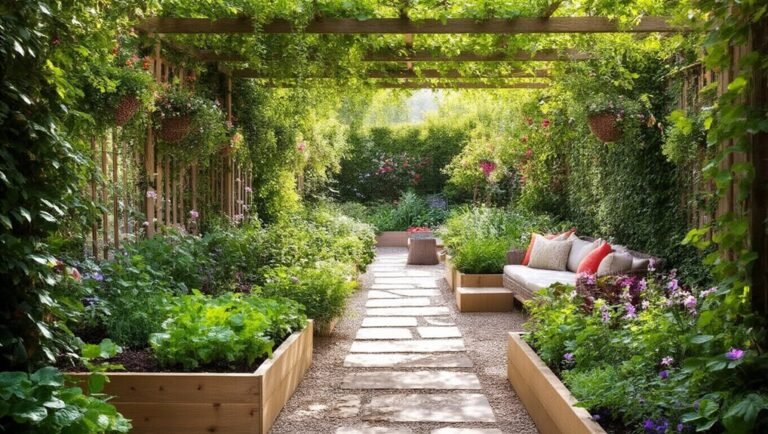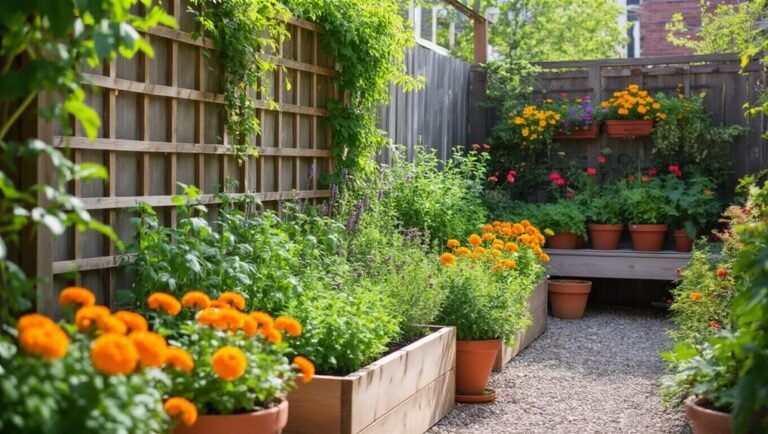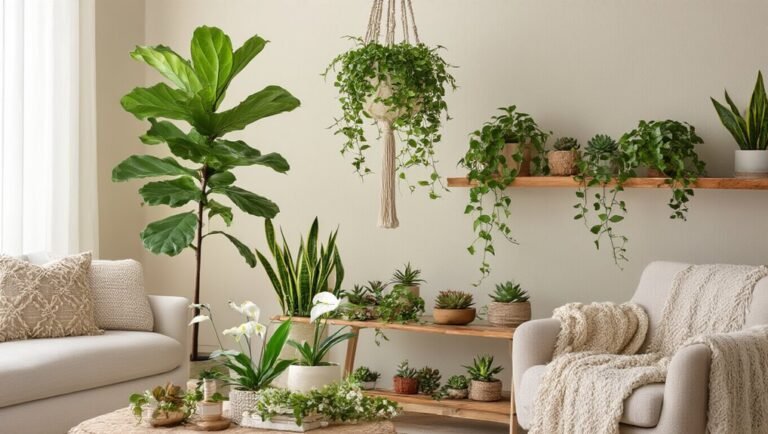To maximize your small garden, utilize smart vertical gardening solutions like wall planters and trellises. Choose compact plants, such as dwarf fruit trees and herbs, to save space. Container gardening is key; arrange pots creatively around your area for visual appeal. Incorporate pathways for guidance and consider adding water features for aesthetics. Seasonal planting strategies can help ensure continuous blooms. Keep these tips in mind, and you’ll unlock even more ideas for your thriving garden oasis.
Key Takeaways
- Utilize vertical gardening techniques with wall planters and trellises to maximize space and enhance plant exposure to sunlight.
- Choose compact plant varieties, such as dwarf fruit trees and herbs, to efficiently use limited garden areas.
- Incorporate creative pathways and raised beds to optimize layout and improve soil quality while adding visual interest.
- Use diverse containers for planting, stacking pots or wall-mounted planters to create a lush garden without occupying much ground space.
- Implement efficient maintenance strategies like drip irrigation and mulching to ensure a thriving garden with minimal effort.
Smart Vertical Gardening Solutions
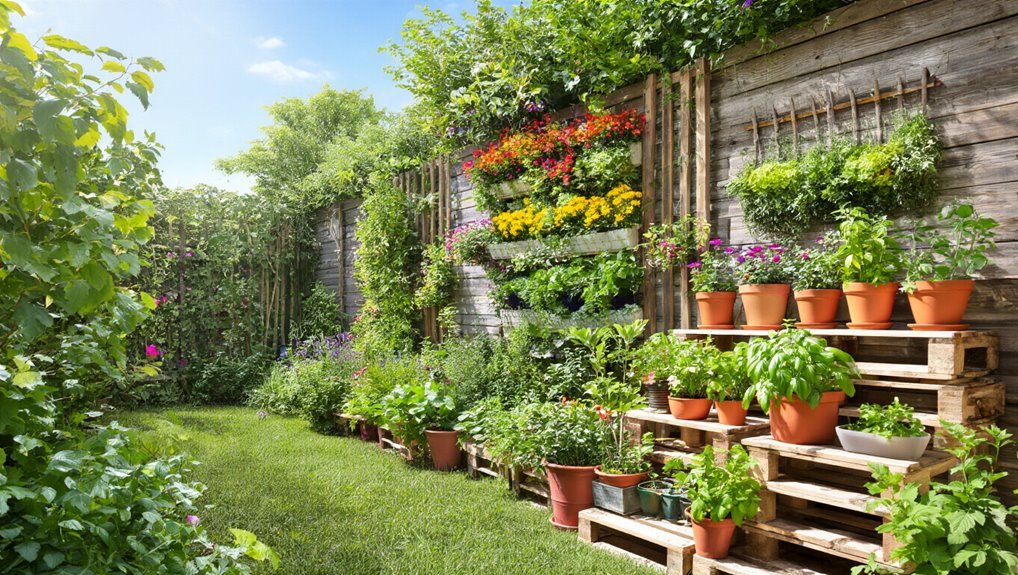
If you’re looking to maximize your small garden space, smart vertical gardening solutions can be a game changer.
By utilizing wall planters, trellises, and vertical shelves, you can create a lush, green environment without sacrificing floor space. Consider hanging pots or using a vertical garden frame to showcase your favorite plants, making them both accessible and visually appealing. Adding beautiful trellises not only supports climbing plants but also adds architectural interest to your garden design.
You can also repurpose old pallets or wooden crates to build stylish tiered gardens, allowing you to grow herbs and flowers at different heights.
These solutions not only enhance your garden’s aesthetics but also improve air circulation and sunlight exposure for your plants.
For an easy start, explore Vertical Garden Kits designed for both beginners and experts to elevate your space with minimal effort.
Embrace vertical gardening, and watch your small space transform into a vibrant, productive oasis!
Choosing the Right Plants for Small Spaces
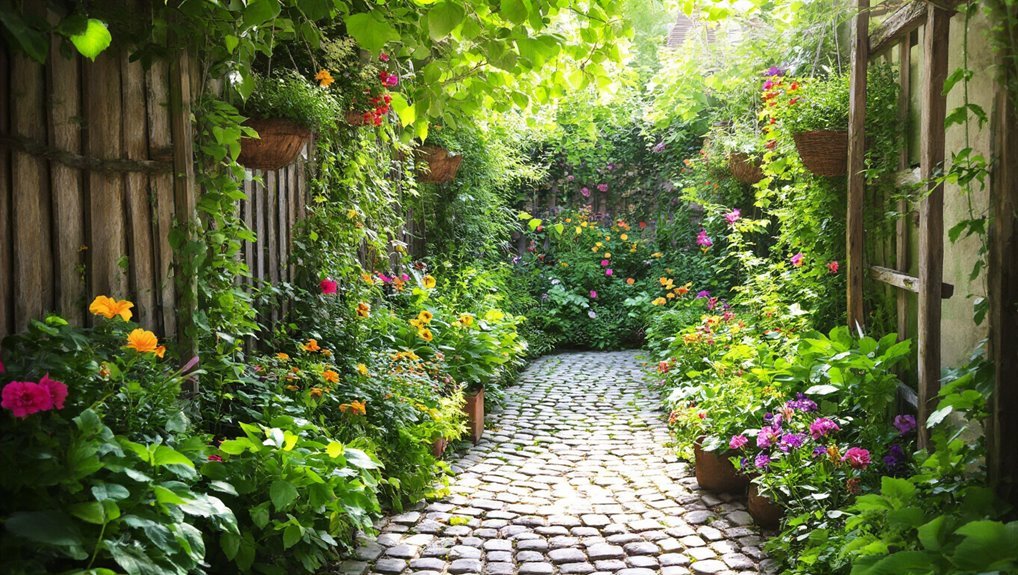
What plants should you choose to make the most of your small garden space? Start with compact varieties that thrive in limited areas.
Herbs like basil, mint, and thyme not only save space but also enhance your culinary creations. Opt for dwarf fruit trees or berry bushes, which provide delicious yields without overwhelming your garden. You might also experiment with edible flower seeds to add both color and flavor to your garden and dishes.
Consider colorful annuals or perennials that attract pollinators and add visual interest. Native plants are also a smart choice; they require less maintenance and adapt well to your local climate.
Lastly, think about layering plants—tall plants at the back and shorter ones in front—to create depth. By selecting the right plants, you’ll maximize your garden’s potential while keeping it manageable and beautiful.
For an easy and convenient way to start your herb garden, consider using Herb Garden Kits with Seeds and Pots that provide everything you need to grow herbs even in small spaces.
Container Gardening: Maximizing Potentials
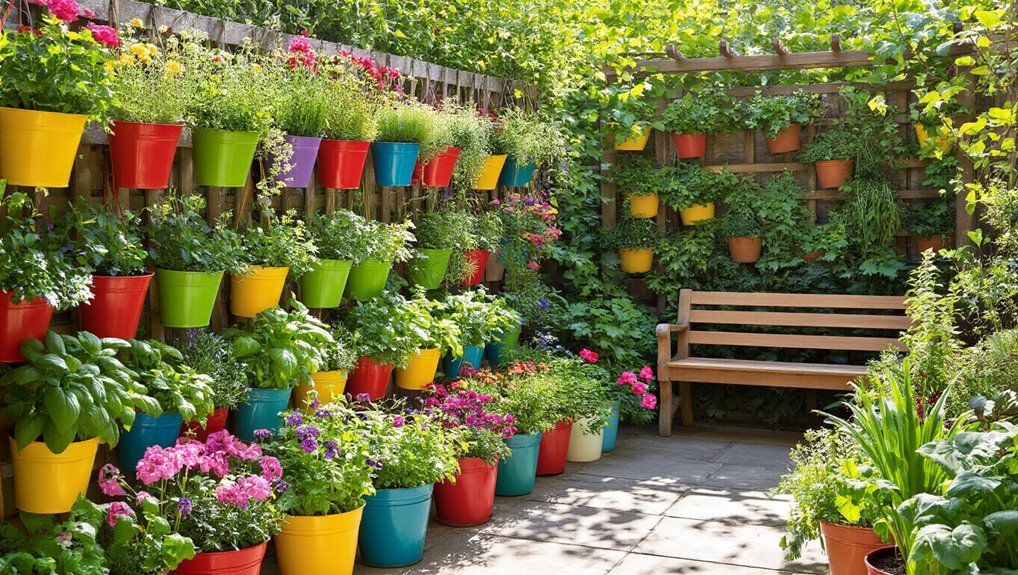
For gardeners with limited space, container gardening offers an excellent way to maximize your planting potential. You can creatively arrange pots on patios, balconies, or even windowsills, transforming any small area into a lush garden. Many people also enjoy growing indoor herb gardens as part of their container setups, allowing for fresh flavors and greenery year-round.
Choose a variety of containers—ceramic, wooden, or even recycled materials—to add visual interest. Prioritize lightweight options for easy mobility and rearranging.
Utilize vertical space by stacking pots or using wall-mounted planters, which can dramatically increase your growing area. Consider drainage and sunlight needs for each plant to ensure they thrive.
With careful selection and placement, you’ll cultivate a vibrant garden that not only beautifies your space but also provides a therapeutic escape right at home. Enhance your setup by selecting beautiful plant pots that elevate both the style and function of your small garden.
Happy planting!
Utilizing Edible Plants in Limited Areas
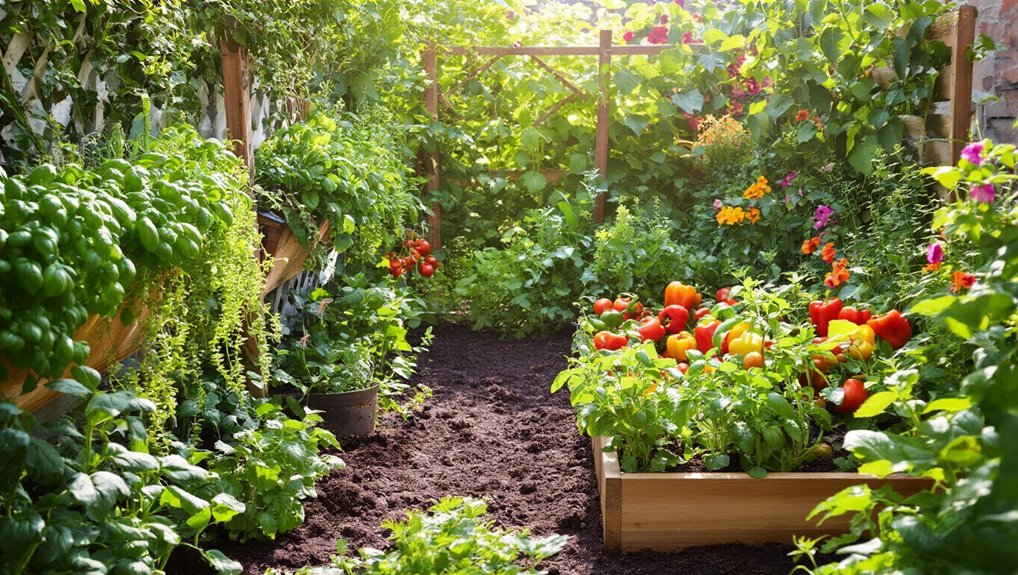
Transforming a small garden into a productive space can be easily achieved by incorporating edible plants.
Focus on vertical gardening techniques; utilize trellises or wall planters to grow climbing vegetables like beans and cucumbers. For optimal results, make sure to provide your plants with the best plant food to support robust growth in vertical systems.
Consider planting herbs like basil, parsley, and mint in small containers or even hanging pots. These not only save space but also add fragrance and flavor to your garden.
Additionally, choose compact varieties of fruits and vegetables, such as dwarf tomatoes or salad greens, which thrive in limited areas.
Interplanting is another effective strategy; mix fast-growing crops with slower ones to maximize your yield.
To further support your plants’ growth and productivity, consider using Plant Fertilizer Tablets to provide essential nutrients in a convenient, space-saving form.
Creative Pathways and Layout Ideas
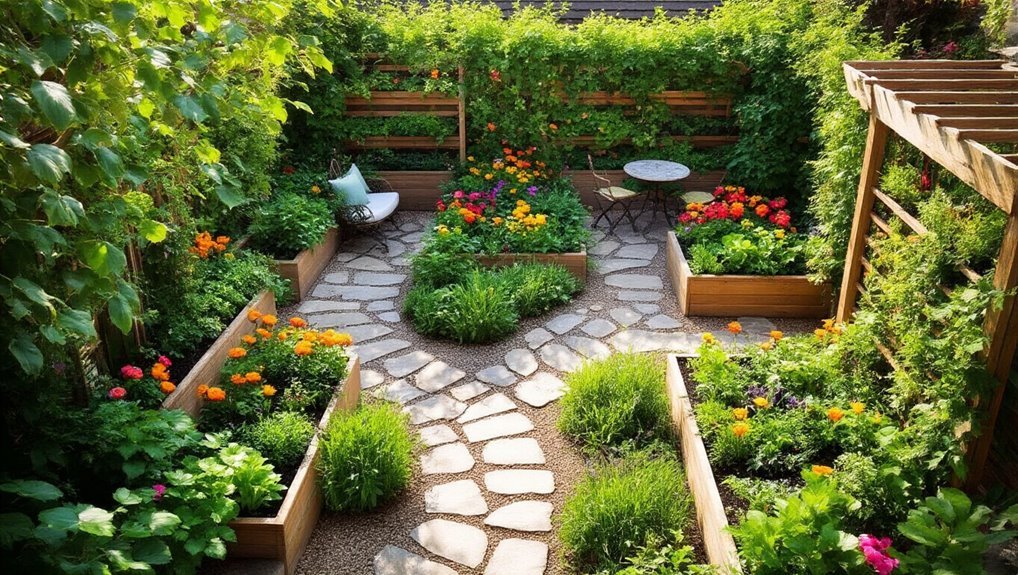
While planning your small garden, consider how creative pathways and layouts can enhance both functionality and aesthetics.
Thoughtful design can transform your space into a delightful retreat. Here are some ideas to inspire you:
- Curved Pathways: Use winding paths to create a sense of mystery and encourage exploration.
- Vertical Gardens: Maximize space by adding vertical elements, making your garden feel larger and more dynamic.
- Stepping Stones: Incorporate natural stones to add texture and guide visitors through your garden. For moving materials or heavy pots along these paths, a garden cart can be an invaluable tool.
- Layered Planting: Arrange plants in tiers to create depth and visual interest.
Integrating raised garden beds into your garden design is a practical way to maximize planting space, improve soil quality, and add structure to your layout.
With these pathways and layouts, you’ll not only save space but also elevate the beauty of your small garden, making it a cherished oasis.
DIY Garden Furniture to Save Space
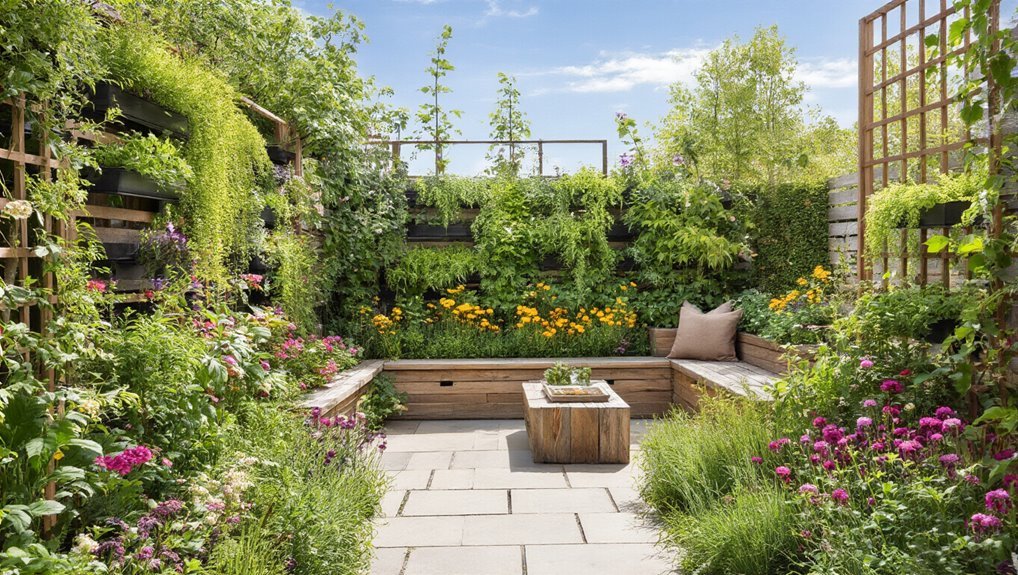
If you want to make the most of your small garden, creating DIY furniture can be a game changer. By crafting multi-functional pieces, you can save space while enhancing your garden’s charm. Consider building a bench that doubles as storage or a table that folds away when not in use. For even more inspiration, you can browse Outdoor Garden Benches to find stylish ideas that suit your space. Another smart addition is installing Garden Tool Organizers to keep your tools tidy and easily accessible, making your garden even more organized.
Here’s a simple table to inspire your DIY projects:
| Furniture Type | Materials Needed | Benefits |
|---|---|---|
| Storage Bench | Wood, hinges, paint | Seating and hidden storage |
| Folding Table | Plywood, brackets | Space-saving, portable |
| Vertical Planter | Wood, pots, screws | Maximizes planting area |
With these ideas, you’ll maximize your small garden’s potential while adding your personal touch. Get creative!
Incorporating Water Features for Aesthetic Appeal
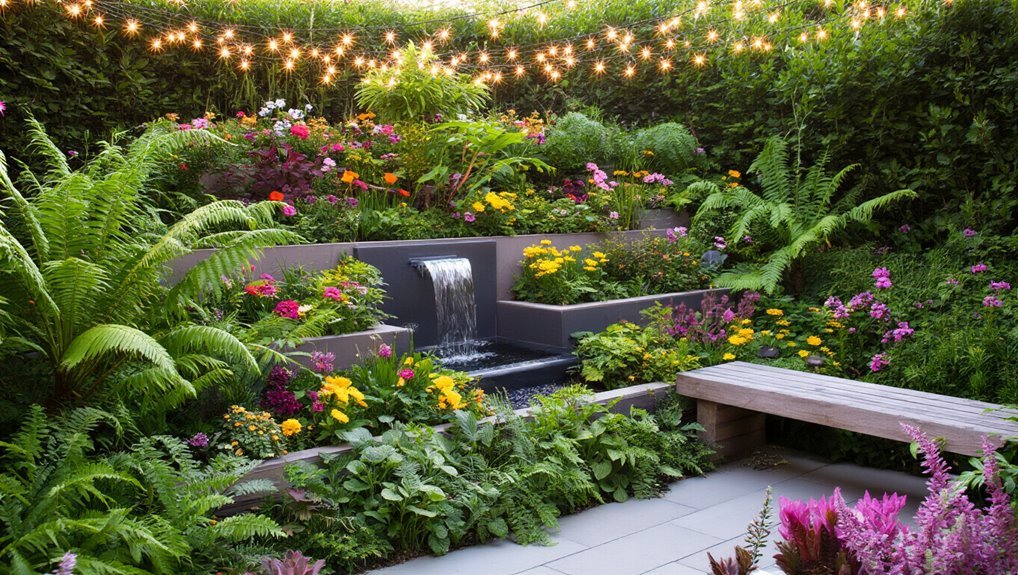
Adding water features can significantly enhance the charm of your small garden, complementing the DIY furniture you’ve created. The soothing sound of flowing water brings a sense of tranquility and invites nature into your space. For evening enjoyment, consider integrating garden lighting (solar lights) around your water features to create a warm and inviting ambiance after sunset.
Here are four ideas to inspire you:
- Miniature Waterfall: Create a small waterfall using stones and a pump; it’s visually stunning and adds a calming atmosphere.
- Container Pond: Use a large container filled with water plants; it’s low maintenance and attracts wildlife.
- Birdbath: Install a charming birdbath to attract birds, providing delightful entertainment as they splash around.
- Fountain: A compact fountain can be a focal point, adding elegance and a gentle sound that enhances relaxation.
For a sustainable option, consider adding solar-powered water features to your garden, which harness sunlight to operate and eliminate the need for electrical wiring. Incorporate these features for a serene retreat.
Seasonal Planting Strategies for Continuous Bloom
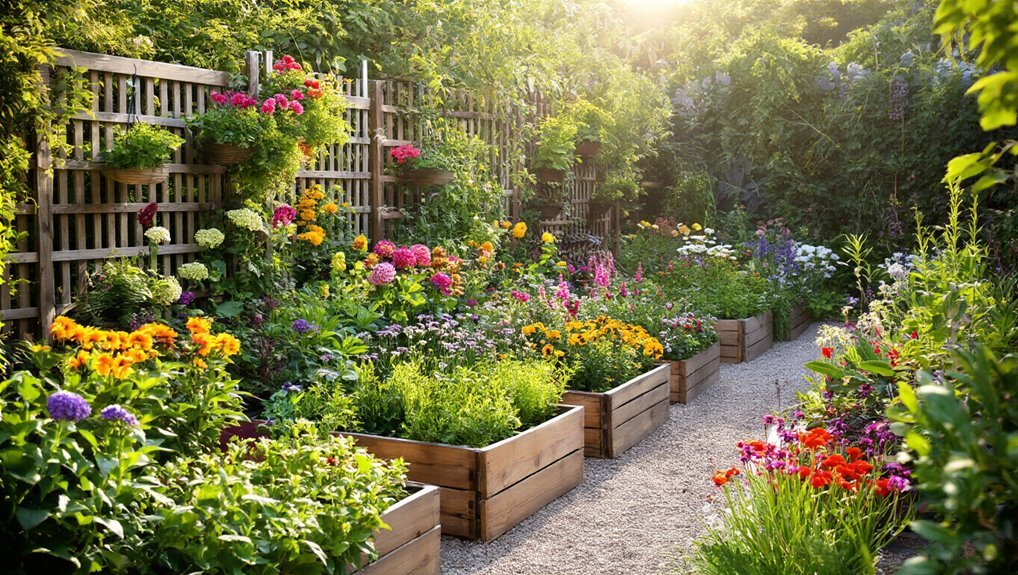
To keep your small garden vibrant throughout the seasons, you can strategically plan your planting to ensure a continuous bloom.
Start by choosing a mix of early, mid, and late-season flowers. For spring, consider planting tulips and daffodils; move to summer favorites like coneflowers and daisies; and finish with fall blooms such as chrysanthemums. Using a seed starting kit can make it easier to get a head start with your favorite flowers and vegetables.
Additionally, intersperse perennial plants with annuals for a dynamic display. Use companion planting to maximize space and encourage growth.
Don’t forget to stagger your planting times to extend your bloom period.
Using planting guides and calendars can help you plan ahead and ensure you’re sowing, transplanting, and harvesting at the optimal times for your region.
Tips for Maintaining a Small Garden Efficiently
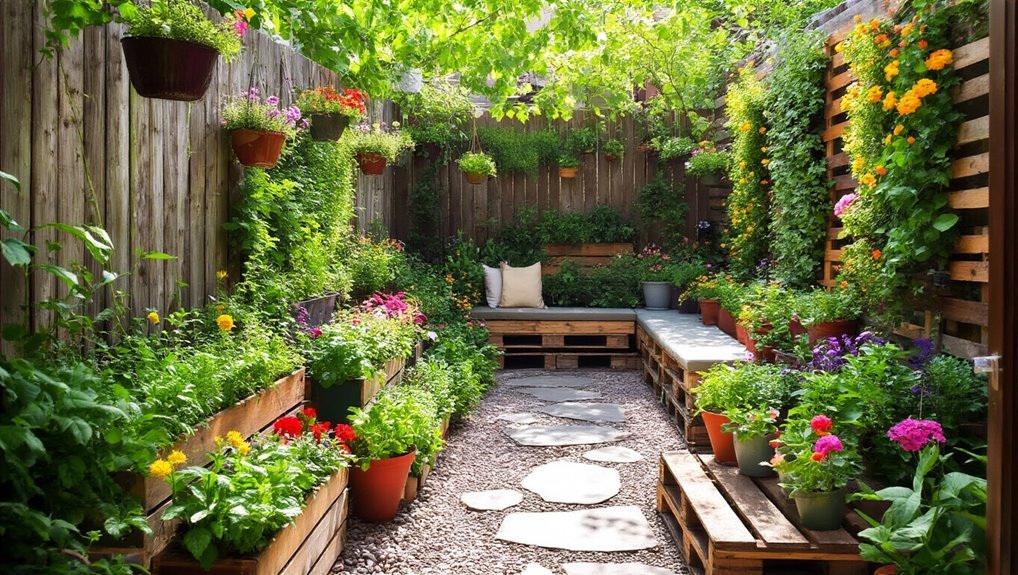
Keeping your small garden blooming beautifully requires not just thoughtful planting but also efficient maintenance.
To ensure your garden thrives, follow these simple yet effective tips:
1. Water Wisely: Use a drip irrigation system or water early morning to minimize evaporation.
You’ll save time and resources!
2. Mulch Regularly: Apply a layer of mulch to retain moisture and suppress weeds.
It’ll make your garden look neat and tidy.
3. Prune Strategically: Regularly trim dead or overgrown plants to encourage growth.
You’ll feel accomplished seeing your garden flourish!
4. Rotate Crops: Change the location of your plants each season.
This keeps the soil healthy and reduces pests.
Frequently Asked Questions
How Can I Attract Pollinators to My Small Garden?
To attract pollinators to your small garden, plant native flowers, create diverse blooms, and avoid pesticides. Adding water sources and shelter, like bee hotels or rocks, will also encourage them to visit and thrive.
What Are the Best Soil Types for Container Gardening?
Imagine your plants dancing in rich, fluffy soil. For container gardening, you’ll want well-draining mixes, like potting soil blended with perlite or vermiculite. These keep roots happy and thriving, ensuring your garden flourishes beautifully.
Can I Compost in a Small Garden?
Yes, you can absolutely compost in a small garden! Use a compact bin or a worm composting system. It’ll help recycle kitchen scraps and enrich your soil without taking up much space.
How Do I Prevent Pests in a Limited Space?
Imagine a tiny fortress defending against invaders. You can prevent pests in your limited space by using companion planting, introducing beneficial insects, and maintaining cleanliness. These strategies create a resilient environment, safeguarding your precious garden.
What Gardening Tools Are Essential for Small Gardens?
You’ll need a few essential tools for your small garden: a hand trowel for planting, pruners for trimming, a watering can for easy hydration, and a kneeling pad to keep you comfortable while working.
Conclusion
With the right strategies, your small garden can become a lush paradise that feels like an expansive oasis! By embracing vertical gardening, choosing the right plants, and getting creative with DIY projects, you’ll maximize every inch of your space. Don’t forget to incorporate pathways and water features for added charm. With a little effort and planning, your garden will not only thrive but also bring joy and beauty to your life all year round.
